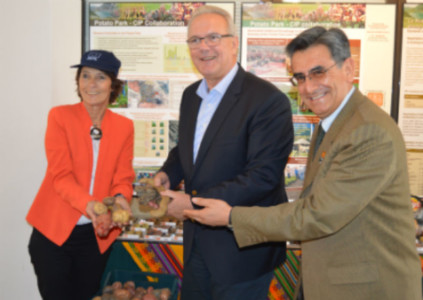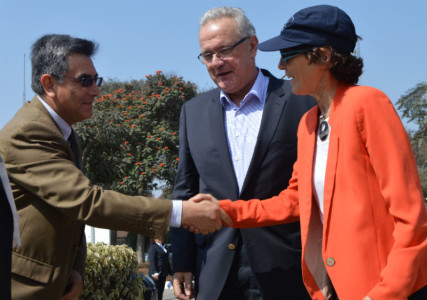Lima, Peru
October 11, 2015
FOR IMMEDIATE RELEASE
Contact: cip-cpad@cgiar.org
European Union Supports Effort to Reduce Child Malnutrition in South America’s Andes Region Using Native Potato Varieties
A group of European Union officials led by the EU Commissioner for International Cooperation & Development, Neven Mimica, visited the headquarters of the International Potato Center (CIP), in Lima, Peru, today to learn about EU-funded efforts to reduce child malnutrition with nutritious native potato varieties.
Despite a decade of strong economic growth, the countries of South America’s Andean region still suffer high levels of poverty, especially in the remote, highland communities of the Andes. According to a report by the Economic Commission for Latin America and the Caribbean, more than 20 percent of children under the age of three in the Andean Region suffer malnutrition, including low levels of iron and zinc that can result in an array of health problems.
Because programs that distribute vitamins in rural areas have had mixed results, CIP promotes the production and consumption of nutrient-rich potato varieties by rural families to achieve sustainable health improvements and income opportunities. A leading research-for-development institution, CIP is delivering sustainable solutions to hunger, poverty and the degradation of natural resources in dozens of countries across Latin America, Africa and Asia.
Since 2010, CIP has led the EU-funded IssAndes project, which works with an array of partners in mountain communities of Bolivia, Colombia, Ecuador and Peru to improve child health and family livelihoods. It achieves this by promoting the cultivation of native potatoes, and diet diversification through the consumption of more vegetables, potatoes and animal protein.
“Issandes has tried to take advantage of potato biodiversity to improve nutrition,” said André Devaux, CIP’s Regional Leader for Latin America and the Caribbean. He noted that there are approximately 5,000 native potato varieties in the Andes region, some of which have high levels of vital nutrients. The Andes region is the potato’s center of origin and its people have been growing and consuming the crop for thousands of years.
Devaux said that in some of IssAndes’ target communities, almost 40 percent of children suffered chronic malnutrition when the project began. He explained that CIP scientists analyzed the nutrient content of hundreds of native potato varieties farmed in the four Andean countries to identify varieties with high levels of iron and zinc. IssAndes then promoted the cultivation and consumption of those potatoes in rural communities, while collaborating with municipal health departments and national institutions.
Devaux noted that IssAndes has brought together 20 partners specialized in areas as diverse has agriculture, rural development, nutrition and health. He explained that while CIP and partners helped Andean farmers to adopt nutritious native potato varieties, improve farming practices, and produce a greater variety of crops, the project worked with local health departments to teach mothers about nutrition and the importance of a diverse diet for their children.
“One important aspect of IssAndes has been its integrated approach to the challenges of malnutrition, combining agriculture with nutrition and health,” Devaux said.
“This project is a key example of what we are trying to achieve under several of the sustainable development goals,” said Commissioner Mimica. “This visit has offered me an excellent example of how participative innovation and the use of technology have a central role in development and in the fight against hunger.”
Since 2010, IssAndes has helped approximately 5,000 farm families to diversify their potato production and consumption. IssAndes has also promoted the concept of using nutritious native potatoes for health improvement to local and national governments, which could benefit thousands more. In the case of Peru, the project’s findings were incorporated into national food security and nutrition policies.
“The EU is committed to continue to contribute to poverty eradication and to foster sustainable development in Latin America through the implementation of regional initiatives such as IssAndes,” said Mimica.
About CIP
The International Potato Center (CIP), headquartered in Lima, Peru, was founded in 1971 as a root and tuber research-for-development institution delivering sustainable solutions to the pressing world problems of hunger, poverty, malnutrition and the degradation of natural resources. CIP houses the global in-trust potato, sweet potato and Andean root and tuber crops collections and contains the world’s largest collection of potato diversity. CIP has regional offices in Peru, Ecuador, Kenya, India and China and is active globally with projects in 30 developing countries across Asia, Africa and Latin America.
CIP is part of the CGIAR Consortium, a global partnership that unites organizations engaged in research for a food secure future. CGIAR research is dedicated to reducing rural poverty, increasing food security, improving human health and nutrition, and ensuring more sustainable management of natural resources. Donors include individual countries, major foundations, and international entities.
About IssAndes
IssAndes is a EU-funded project led by CIP that has worked since 2010 to improve child nutrition in vulnerable rural communities in Peru, Bolivia, Ecuador and Colombia through agricultural innovation. In Peru, CIP has worked in Apurimac department in partnership with CARE Peru and CAPAC Peru, and in Huancavelica with PRISMA and ADERS Peru, as well as with the Institute for Nutrition Research (IIN). IssAndes reinforces Andean farming systems based on nutrient-rich native potatoes in order to improve incomes, while promoting diet diversity and quality, and income opportunities.


